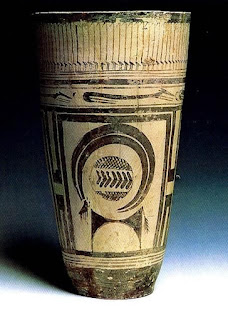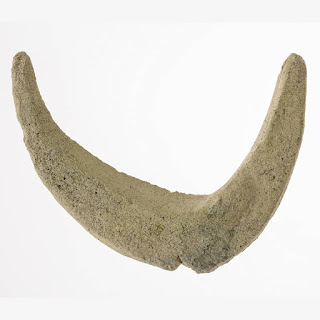Beautiful Scarlet-Ware Vase from Tell Agrab, beginning of the 3rd millennium BC. The vase depicts Ibex goat among vegetation, with birds and fish.
Interestingly, the goat is not only surrounded with plants. Plants actually grow out of its back...What does all this mean?
The climatic year in the Tell Agrab area, like in the rest of Iraq, is divided into two halves: hot dry, half (May-Oct) and cool, wet half (Nov-Apr)...
The beginning of the rain season (Oct/Nov), which brings revival of nature and makes everything green and lush again, coincides with the beginning of the mating season of local Bezoar Ibex goats...
Hence the importance of the "Goat of Rain" in the local cultures, illustrated by the fact ibex goat was the most depicted animal on the local artefacts...
I talked about this in my posts "Flamingos from Susa", "Goat carrier"...and many others...
Which is why on this vase we see small green plants actually growing out of the Ibex back...This is not the only such symbolic depiction of this link between ibexes and vegetation from the area. Here is another one from my post "Iranian goat of rain"...
Something interesting. What are these small plants growing out of the back of the Goat of Rain? Any random generic plants?
I don't think so. I think it's grass and young grain and reeds.
Because of the climate in the region, the grass growing season is the rain season, symbolised by the goat of rain...I talked about this in my post "Green pastures"...Which is why winter (Oct/Nov-Apr/May) was the grass grazing season...
Now once the rain season ends, in Apr/May, the grass quickly withers and dies under the scorching summer sun...But luckily, this exactly when the grains and reeds harvest season starts...
Which is why the two plants depicted on either side of the goat are reed and grain...
I think that the plant in front of the ibex is actually reed that grows in flood plains of lower Mesopotamia...
Reeds were an important crop in Mesopotamia, as important as grain. Reeds were used as building material for building irrigation canal dams, houses and boats, and for making baskets, mats and furniture...
I talked about this in my post "Canals"...And it turned out the best time to cut reeds for building purposes was in August, during the hottest and driest time, in Leo...Hence Shamash with a serrated reed cutting knife...Between lions...in an empty river, canal bed...
What I didn't know until today is that the reeds were also used as animal fodder. From everything I managed to find about the common reed lifecycle, it seems that in the climatic zones like Mesopotamia, "...the above-ground biomass increases from February until it reached its maximum during August and then decreased again. Moreover, the nutrient content (g/m2) increased from the early growing season (Feb) and reached its peak during Apr–Aug and then decreased..."
Which means that the best time to harvest reeds for animal fodder is between Apr and Aug...Exactly the same time when grain is harvested...
And I think that the plant behind Ibex goat is grain...That this is indeed symbol for grain, can be seen from the fact that the same symbol was put on grain granaries in Kurdistan until 20th century. Aliabad women standing beside a grain bin, Iranian Kurdistan...From "Home is where we keep our food: The origins of agriculture and Late Pre-Pottery Neolithic food storage". Very important image, as it confirms that this design pattern, found on pottery and figurines since the Earliest Neolithic all over Eurasia, means "grain"...
I talked about this in my post "Scarlet-ware harvest vase"...
Today I came across this interesting book, "Mesopotamian Civilization: The Material Foundations" By Daniel T. Potts. And in it I came across this passage:
"...Microwear studies of Ubaid clay sickles from Tell Oueilli have suggested that these common tools could have been used for cutting reeds. And a new study of their distribution in Southern Mesopotamia suggests that this may indeed have been their primary function, rather them having been used for harvesting cereal...[My comment: Although they could have been used for both]...Virtually identical clay sickles were used during Late Uruk period as well..."
Here is one of these clay sickles from the site of Chogha Mish in Iran, ca. 3400–3100 BC, currently kept in the Oriental Institute in Chicago...
From my article about the development of sickles...
I am not sure what bird is depicted standing on the Ibex's back. It is most likely one of many bird species that used to spend winters in the Mesopotamian marshes, while they still existed...Could it be a common crane? See the bushy tail?
The common crane lives in Northern Eurasia, but winters in Southern Asia and North Africa, Including Mesopotamia.
According to "Cranes of the World: Eurasian Crane (Grus grus)" by Paul A. Johnsgard, Cranes gather in huge numbers in Eastern Turkey in Sep/Oct, from where they fly down to the marshlands of Mesopotamia...Right in time for the beginning of the mating season of the Ibex goats, and the beginning of the rain season, Oct/Nov...
Oh, and right at the time for grain sowing...Hence cranes depicted flying over the sowing seen on this seal.
You can read more about this and other similar seals in my post "Ploughing"...
And cranes all leave the Mesopotamian marshes by Apr/May, the end of the rain season symbolised by the goat of rain...
Hence the bird depicted standing on the goat...I think...
One other thing...The fishes...Is the reason why fishes are depicted swimming towards "The Mountain Goat" the same reason they are depicted swimming towards Enki?
I explained why they swim towards Enki in my post "Goatfish"...
So the scene depicts winter, cool, wet half of the year. The half of the year when Ibex goats mate, migratory birds arrive and everything is green again...The half of the year which ends in grain and reed harvest and fishes swimming towards mountain goats...
The vase images are from this great publication by the University of Chicago: "OIP 63 Pottery from the Diyala Region"...
To read more about ancient animal and plant calendar markers, start here…then check the rest of the blog posts related to animal calendar markers I still didn't add to this page, and finally check my twitter threads I still didn't convert to blog post...I am 9 months behind now...
















I'm wondering if the ibex horn or crane bill ever could have been used in reed or grain gathering/processing.
ReplyDelete